The Main Controlling Factors of the Cambrian Ultra-Deep Dolomite Reservoir in the Tarim Basin
Abstract
:1. Introduction
2. Geological Setting
3. Distribution Characteristics of Porosity and Permeability
3.1. Series2
3.2. Miaolingian
3.3. Furongian
4. Main Controlling Factors of Favorable Reservoirs in the Tarim Basin
4.1. Unconventional Reservoirs
4.2. Main Controlling Factors for Conventional Reservoir
4.2.1. Controlling Factors during the Deposition Stage of Dolomite Reservoirs
- Tectonism
- 2.
- Sedimentary environment
- 3.
- Microorganism
4.2.2. Controlling Factors during the Diagenetic Stage of Dolomite Reservoirs
- Diagenesis
- 2.
- Structure and fracture development
- 3.
- Dissolution and filling effect
5. Conclusions
Author Contributions
Funding
Data Availability Statement
Acknowledgments
Conflicts of Interest
References
- Zhou, C.N.; Zhang, G.Y.; Tao, S.Z.; Hu, S.Y.; Li, X.D.; Li, J.Z.; Dong, D.Z.; Zhou, R.K.; Yuan, X.J.; Hou, L.H.; et al. Geological features, major discoveries and unconventional petroleum geology in the global petroleum exploration. Pet. Explor. Dev. 2010, 37, 129–145. [Google Scholar]
- Sun, L.D.; Zou, C.N.; Zhou, R.K.; Zhang, Y.H.; Zhang, S.C.; Zhang, B.M.; Zhu, G.Y.; Gao, Z.Y. Formation, distribution and potential of deep hydrocarbon resources in China. Pet. Explor. Dev. 2013, 40, 687–695. [Google Scholar] [CrossRef]
- Zhu, G.Y.; Cao, Y.H.; Yan, L.; Yang, H.J.; Sun, C.H.; Zhang, Z.Y.; Li, T.T.; Chen, Y.Q. Potential and favorable areas of petroleum exploration of ultra–deep marine strata more than 8000 m deep in the Tarim Basin, Northwest China. J. Nat. Gas Geosci. 2018, 3, 321–337. [Google Scholar] [CrossRef]
- Li, J.Z.; Tao, X.W.; Bai, B.; Huang, S.P.; Jiang, Q.C.; Zhao, Z.Y.; Chen, Y.Y.; Ma, D.B.; Zhang, L.P.; Li, N.X.; et al. Geological conditions, reservoir evolution and favorable exploration directions of marine ultra-deep oil and gas in China. Pet. Explor. Dev. 2021, 48, 52–67. [Google Scholar] [CrossRef]
- Pang, X.Q.; Lin, H.X.; Zheng, D.Y.; Li, H.L.; Zou, H.Y.; Pang, H.; Hu, T.; Guo, F.X.; Li, H.Y. Basic Characteristics and Dynamic Mechanisms of Formation and Distribution of Deep and Ultra-Deep Carbonate Rock Oil and Gas Reservoirs in China, and Development Directions. J. Geomech. 2020, 26, 673–695. [Google Scholar]
- Li, F.; Zhu, G.Y.; Lv, X.X.; Zhang, Z.Y.; Wu, Z.H.; Xue, N.; He, T.; Wang, R. Controversy over the Origin of Paleozoic Marine Oil and Gas in the Tarim Basin and Identification of the Cambrian as the Main Source Rock for Hydrocarbons. Acta Pet. Sin. 2021, 42, 1417–1436. [Google Scholar]
- Teng, J.P.; Zhu, T.; Zheng, L.; Zhao, Y.S.; Lin, L.J. Advancing into the Ultra-Deep: Drilling the “Underground Everest”. Sci. Technol. Dly. 2022, 8, 18. [Google Scholar]
- Zhu, G.Y.; Li, J.F.; Zhang, Z.Y.; Wang, M.; Xue, N.; He, T.; Zhao, K. Stability and cracking threshold depth of crude oil in 8000 m ultra-deep reservoir in the Tarim Basin. Fuel 2020, 282, 118777. [Google Scholar] [CrossRef]
- Yang, H.J.; Chen, Y.Q.; Pan, W.Q.; Wang, B.; Yang, W.J.; Huang, S.Y.; Yang, P.F.; Yi, Y.; Wang, X.X. Study on tectonic and sedimentary evolution during the Nanhua-Middle Cambrian and its significance for subsalt exploration, Tarim Basin. China Pet. Explor. 2021, 26, 84–98. [Google Scholar]
- Xu, Q.L.; Cheng, Y.Z.; You, D.H.; Zhang, Y.; Li, X.L.; Xu, J.; Chen, X.D. Characteristics and Formation Mechanism of Multiscale Storage Spaces in Ancient Deep Tight Reservoirs: Examples from the Cambrian Yurtus Formation in the Northern Tarim Basin, China. Lithosphere 2022, 2022, 8449840. [Google Scholar] [CrossRef]
- Bjørlykke, K.; Jahren, J. Open or closed geochemical systems during diagenesis in sedimentary basins: Constraints on mass transfer during diagenesis and the prediction of porosity in sandstone and carbonate reservoirs. AAPG Bull. 2012, 96, 2193–2214. [Google Scholar] [CrossRef]
- Ehrenberg, S.N.; Walderhaug, O.; Bjørlykke, K. Carbonate porosity creation by mesogenetic dissolution: Reality or illusion? AAPG Bull. 2012, 96, 217–233. [Google Scholar] [CrossRef]
- Moore, C.H.; Wade, W.J. Summary of early diagenesis and porosity modification of carbonate reservoirs in a sequence stratigraphic and climatic framework. In Developments in Sedimentology; Elsevier: Amsterdam, The Netherlands, 2013; Volume 67, pp. 207–238. [Google Scholar] [CrossRef]
- Zhu, Y.J.; Zheng, J.F.; Zhang, J.K.; Luo, X.S.; Yu, G.; Li, J.; Hu, F.J.; Yang, G. Facies, depositional environment and reservoir quality of an early Cambrian carbonate ramp in the Tarim Basin, NW China. Minerals 2023, 13, 791. [Google Scholar] [CrossRef]
- Saller, A.H.; Henderson, N. Distribution of porosity and permeability in platform dolomites: Insight from the Permian of west Texas. AAPG Bull. 1998, 82, 1528–1550. [Google Scholar]
- Sibley, D.F. Climatic control of dolomitization, Seroe Domi Formation (Pliocene), Bonaire, NA. Soc. Econ. Paleontol. Mineral. Spec. Publ. 1980, 28, 247–258. [Google Scholar]
- Yun, L.; Zhai, X.X. Discussion on characteristies of the Cambrian reservoirs and hydrocarbon accumulation in Well Tashen-1, Tarim Basin. Oil Gas Geol. 2008, 29, 726–732. [Google Scholar]
- Cao, Z.C.; YOU, D.H.; Qi, L.X.; Yun, L.; Hu, W.X.; Li, Z.J.; Qian, Y.X.; Liu, Y.L. New insights of the genesis of ultra-deep dolomite reservoirs in Well TS1, Tarim Basin: Evidence from in situ carbon and oxygen isotope analysis. Nat. Gas Geosci. 2020, 31, 915–922. [Google Scholar]
- Meng, X.H.; Zhang, S.N.; Li, X.H.; Lin, J. Reservoir space in the Cambrian in the Ultradeep Well No. l, Tarim Basin. Acta Geol. Sichuan 2010, 30, 31–34. [Google Scholar]
- Meng, X.H.; Zhang, S.N.; Lin, J.; Tian, J.; Lu, J.P. Geochemical tracting of isotopic fluid of the Cambrian dolomite reservoir in well Tashen 1. J. Mineral. Petrol 2009, 29, 75–82. [Google Scholar]
- Zhu, G.Y.; Huang, H.P.; Wang, H.T. Geochemical Significance of Discovery in Cambrian Reservoirs at Well ZS1 of the Tarim Basin, Northwest China. Energy Fuels 2015, 29, 1332–1344. [Google Scholar] [CrossRef]
- Jiang, L.; Worden, R.H.; Cai, C.F.; Shen, A.J.; Crowley, S.F. Diagenesis of an evaporite-related carbonate reservoir in deeply buried Cambrian strata, Tarim Basin, Northwest China. AAPG Bull. 2018, 102, 77–102. [Google Scholar] [CrossRef]
- Jia, L.Q.; Cai, C.F.; Zhang, J.G.; Liu, L.J.; Luo, Q.Y.; Li, K.K. Effect of thermochemical sulfate reduction on carbonate reservoir quality: Cambrian and Ordovician oilfield, Tazhong area, Tarim basin, China. Mar. Pet. Geol. 2021, 123, 104745. [Google Scholar] [CrossRef]
- Zheng, H.R.; Wu, M.B.; Wu, X.W.; Zhang, T.; Liu, C.Y. Oil-gas exploration prospect of dolomite reservoir in the Lower Paleozoic of Tarim Basin. Acta Pet. Sin. 2007, 28, 1–8. [Google Scholar]
- Zhu, G.Y.; Chen, F.R.; Chen, Z.Y.; Zhang, Y.; Xing, X.; Tao, X.W.; Ma, D.B. Discovery and Basic Characteristics of High-Quality Hydrocarbon Source Rocks in the Cambrian Yuertusi Formation of the Tarim Basin. Nat. Gas Geosci. 2016, 27, 8–21. [Google Scholar]
- Zhu, G.Y.; Zhang, Y.; Zhou, X.X.; Zhang, Z.Y.; Du, D.D.; Shi, S.B.; Li, T.T.; Chen, W.Y.; Han, J.F. TSR, deep oil cracking and exploration potential in the Hetianhe gas field, Tarim Basin, China. Fuel 2019, 236, 1078–1092. [Google Scholar] [CrossRef]
- Wang, Q.; Hao, F.; Cao, Z.C.; Tian, J.Q. Heteroatom compounds in oils from the Shuntuoguole low uplift, Tarim Basin characterized by (+ESI) FT-ICR MS: Implications for ultra-deep petroleum charges and alteration. Mar. Pet. Geol. 2021, 134, 105321. [Google Scholar] [CrossRef]
- Xu, Z.P.; Chen, S.P.; Luo, C.M.; Yang, G.; Xu, S.D.; Hu, F.J.; Lou, H.; Lv, H.X. Distribution and sealing capacity evaluation of gypsum-salt rocks in the Middle Cambrian in Tarim Basin. China Pet. Explor. 2023, 28, 54–67. [Google Scholar]
- Kerans, C.; Lucia, F.J.; Senger, R.K. Integrated characterization of carbonate ramp reservoirs using Permian San Andres Formation outcrop analogs. AAPG Bull. 1994, 78, 181–216. [Google Scholar]
- Sun, S.Q. Dolomite reservoirs: Porosity evolution and reservoir characteristics. AAPG Bull. 1995, 79, 186–204. [Google Scholar]
- Seyyedattar, M.; Zendehboudi, S.; Butt, S. A comprehensive review on fluid and rock characterization of offshore petroleum reservoirs: Tests, empirical and theoretical tools. J. Porous Media 2019, 22, 1697–1755. [Google Scholar] [CrossRef]
- Tian, X.; Huang, H.; Cheng, S.; Wang, C.; Li, P.; Hao, Y. A carbonate reservoir prediction method based on deep learning and multiparameter joint inversion. Energies 2022, 15, 2506. [Google Scholar] [CrossRef]
- Puttiwongrak, A.; Giao, P.H.; Vann, S. An easily used mathematical model of porosity change with depth and geologic time in deep shale compaction. GEOMATE J. 2020, 19, 108–115. [Google Scholar] [CrossRef]
- Wang, X.; Algeo, T.J.; Li, C.; Zhu, M. Spatial pattern of marine oxygenation set by tectonic and ecological drivers over the Phanerozoic. Nat. Geosci. 2023, 16, 1020–1026. [Google Scholar] [CrossRef]
- Tang, L.J. Major evolutionary stages of Tarim Basin in Phanerozoic Time. Earth Sci. Front. 1997, 4, 318–324. [Google Scholar]
- Lin, C.S.; Yang, H.J.; Liu, J.Y.; Peng, L.; Cai, Z.Z.; Yang, X.F.; Yang, Y.H. Paleostructural geomorphology of the Paleozoic central uplift belt and its constraint on the development of depositional facies in the Tarim Basin. Sci. China (Ser. D Earth Sci.) 2009, 52, 823–834. [Google Scholar] [CrossRef]
- Huang, Y.; Fan, T.L.; Berra, F. Architecture and paleogeography of the Early Paleozoic carbonate systems in the east-central Tarim Basin (China): Constraints from seismic and well data. Mar. Pet. Geol. 2020, 113, 104147. [Google Scholar] [CrossRef]
- Zhang, K.H.; You, X.L.; Wu, Y.F.; Zhao, Y.J.; Wang, J. The Main Controlling Factors on the Evolution of the Cambrian Carbonate Platform in the Tarim Basin and Its Implications for the Distribution of Ultra-Deep Dolomite Reservoirs. Minerals 2023, 13, 245. [Google Scholar] [CrossRef]
- Ye, N.; Li, Y.T.; Gong, Y.M.; Liu, D.; Xie, S.W. Sequence Stratigraphic Characteristics of the Cambrian in the Tarim Basin. Xinjiang Geol. 2014, 32, 487–493. [Google Scholar]
- Wei, G.Q.; Zhu, Y.J.; Zheng, J.F.; Yu, G.; Ni, X.F.; Yan, L.; Tian, L.; Huang, L.L. Tectonic-lithofacies paleogeography, large-scale source-reservoir distribution and exploration zones of Cambrian subsalt formation, Tarim Basin, NW China. Pet. Explor. Dev. 2021, 48, 1289–1303. [Google Scholar] [CrossRef]
- Yu, H.Y.; Cai, C.F.; Zheng, J.F.; Huang, L.L.; Yuan, W.F. Influence of Microbial Structures on the Pore Characteristics of Microbial Dolomites: A Case Study of the Xiaoerbuleke Formation in the Keping Area of the Tarim Basin. Pet. Exp. Geol. 2018, 40, 233–243. [Google Scholar]
- Zheng, J.F.; Shen, A.J.; Yang, H.X.; Zhu, Y.J.; Liang, F. Geochemistry, Chronology Characteristics of the Sinian Microbial Dolomites on the Northwestern Margin of the Tarim Basin and Their Geological Significance. Acta Petrol. Sin. 2021, 37, 2189–2202. [Google Scholar]
- Wei, T.Y.; Cai, C.F.; Hu, Y.J.; Liu, D.W.; Jiang, Z.W. Reservoir Genesis of the Lower Cambrian Xiaoerbuleke Formation in the Tarim Basin. Acta Sedimentol. Sin. 2023, 41, 527–544. [Google Scholar]
- Liu, L.H.; Han, M.; Gao, Y.J.; Zhang, Y.Y.; Liu, C.X.; Duan, Y.; Yang, Y.X.; Jiang, K.P. Main reservoir controlling factors and diagenetic evolution of the Xiao’erbulak Formation of Tarim Basin, NW China: A case study of Well KPN1 in Kalpin area. J. Nat. Gas Geosci. 2023, 8, 263–278. [Google Scholar] [CrossRef]
- Peng, Y. Study on Cambrian Carbonate Reservoirs in the Tarim Basin. Master’s Thesis, China University of Petroleum, Beijing, China, 2016. [Google Scholar]
- Bai, Y.; Xu, A.N.; Liu, W.; Zhao, Z.Y.; Luo, P. Sedimentary characteristics of Lower and Middle Cambrian diamict in the northwestern Tarim Basin. Nat. Gas Ind. 2019, 39, 46–57. [Google Scholar]
- Bai, Y.; Li, J.Z.; Liu, W.; Xu, Z.H.; Xu, W.L.; Li, X.; Taskyn, A. Dolomite Characteristics and Multiple Dolomitization Models of the Lower Cambrian in the Northwestern Tarim Basin. Acta Pet. Sin. 2021, 42, 1174–1191. [Google Scholar]
- Song, J.M.; Luo, P.; Yang, S.S.; Yang, D.; Zhou, C.M.; Li, P.W.; Zhai, X.F. Reservoirs of Lower Cambrian microbial carbonates, Tarim Basin, NW China. Pet. Explor. Dev. 2014, 41, 449–459. [Google Scholar] [CrossRef]
- Li, P.W.; Luo, P.; Song, J.M.; Jin, T.F.; Wang, G.Q. Characteristics and main controlling factors of microbial carbonate reservoirs: A case study of Upper Sinian-Lower Cambrian in northwestern margin of Tarim Basin. Acta Pet. Sin. 2015, 36, 1074–1089. [Google Scholar]
- Du, J.H.; Pan, W.Q. Accumulation Conditions and Play Targets of Oil and Gas in the Cambrian Subsalt Dolomite, Tarim Basin, NW China. Pet. Explor. Dev. 2016, 43, 360–374. [Google Scholar] [CrossRef]
- Huang, Q.Y.; Hu, S.Y.; Pan, W.Q.; Liu, W.; Zhang, Y.Q.; Shi, S.Y.; Wang, K. Characteristics and controlling factors of the Cambrian carbonate reservoirs in Bachu area, Tarim Basin, NW China. Nat. Gas Geosci. 2016, 27, 982–993. [Google Scholar]
- Shen, A.J.; Zheng, J.F.; Chen, Y.Q.; Ni, X.F.; Huang, L.L. Characteristics, origin and distribution of dolomite reservoirs in Lower-Middle Cambrian, Tarim Basin, NW China. Pet. Explor. Dev. 2016, 43, 375–385. [Google Scholar] [CrossRef]
- Jiang, L.; Cai, C.F.; Worden, R.H.; Crowley, S.F.; Jia, L.Q.; Zhang, K.; Duncan, I.J. Multiphase Dolomitization of Deeply Buried Cambrian Petroleum Reservoirs, Tarim Basin, North-West China. Sedimentology 2016, 63, 2130–2157. [Google Scholar] [CrossRef]
- Bai, Y.; Luo, P.; Wang, S.; Zhou, C.M.; Zhai, X.F.; Wang, S.; Yang, Z.Y. Structure characteristics and major controlling factors of platform margin microbial reef reservoirs: A case study of Xiaoerbulak Formation, Lower Cambrian, Aksu area, Tarim Basin, NW China. Pet. Explor. Dev. 2017, 44, 377–386. [Google Scholar] [CrossRef]
- Yan, W.; Zheng, J.F.; Chen, Y.Q.; Huang, L.L.; Zhou, P.; Zhu, Y.J. Characteristics and genesis of dolomite reservoir in the Lower Cambrian Xiaoerblak formation, Tarim basin. Mar. Orig. Pet. Geol. 2017, 22, 39–47. [Google Scholar]
- Li, B.; Peng, J.; Yang, S.J.; Xia, Q.S.; Xu, Q.Q.; Hao, Y.Q. Genetic model and characteristics of the Cambrian Xiaoerblak reservoir in Bachu area, Tarim basin. Pet. Geol. Exp. 2017, 39, 797–804, (In Chinese with English abstract). [Google Scholar]
- Zhang, J.Z.; Wang, Z.M.; Yang, H.J.; Xu, Z.M.; Xiao, Z.Y.; Li, Z.X. Origin and differential accumulation of hydrocarbons in Cambrian sub-salt dolomite reservoirs in zhongshen area, Tarim Basin, NW China. Pet. Explor. Dev. 2017, 44, 40–47. [Google Scholar] [CrossRef]
- Deng, S.B.; Guan, P.; Pang, L.; Liu, P.X.; Jin, Y.Q.; Zhang, Y.Q. Genesis of excellent Xiaoerbulak microbial carbonate reservoir in the Kalpin area of Tarim basin. Acta Sedimentol. Sin. 2018, 36, 1218–1232, (In Chinese with English abstract). [Google Scholar]
- Peng, J.; Wang, X.L.; Han, H.D.; Yin, S.; Xia, Q.S.; Li, B. Simulation for the dissolution mechanism of Cambrian carbonate rocks in Tarim Basin, NW China. Pet. Explor. Dev. 2018, 45, 431–441. [Google Scholar] [CrossRef]
- Qiao, Z.F.; Shen, A.J.; Ni, X.F.; Zhu, Y.J.; Yan, W.; Zheng, J.F.; Huang, L.L.; Sun, X.W. Types of Mound and Beach Systems in the Lower Cambrian Xiaoerbulake Formation of the Tarim Basin and Their Significance for Exploration. Pet. Nat. Gas Geol. 2019, 40, 392–402. [Google Scholar]
- Zheng, J.F.; Chen, Y.Q.; Huang, L.L.; Yan, W.; Ni, X.F.; Li, B.H.; Guo, X.Y. Reservoir modeling of the lower Cambrian Xiaoerblak formation in the Sugaitblak section and its significance for exploring regions in the Tarim Basin. NW China. Acta Sedimentol. Sin. 2019, 37, 601–609. [Google Scholar]
- Zheng, J.F.; Yuan, W.F.; Huang, L.L.; Pan, W.Q.; Qiao, Z.F.; Yang, G. Sedimentary facies model and its exploration significance of the lower Cambrian Xiaoerblak formation in Xiaoerblak area, Tarim Basin. J. Paleogeogr. 2019, 21, 589–602. [Google Scholar]
- Cheng, L.J.; Li, Z.; Liu, J.Q.; Yu, J.B. Diagenesis and physical properties of subsalt dolomite reservoirs of the Cambrian, Bachu-Tazhong areas, Tarim Basin. Oil Gas Geol. 2020, 41, 316–327. [Google Scholar]
- Liu, P.X.; Deng, S.B.; Guan, P.; Jin, Y.Q.; Wang, K.; Chen, Y.Q. The nature, type, and origin of diagenetic fluids and their control on the evolving porosity of the Lower Cambrian Xiaoerbulak Formation dolostone, northwestern Tarim Basin, China. Pet. Sci. 2020, 17, 873–895. [Google Scholar] [CrossRef]
- Zhang, X.J.; Han, H.D.; Peng, J.; Gou, Y.C. Multifractal analysis of pore structure and evaluation of deep-buried Cambrian dolomite reservoir with image processing: A case from Tarim Basin, NW China. Geofluids 2020, 2020, 7131573. [Google Scholar] [CrossRef]
- Zheng, J.F.; Pan, W.Q.; Shen, A.J.; Yuan, W.F.; Huang, L.L.; Ni, X.F.; Zhu, Y.J. Reservoir geological modeling and significance of Cambrian Xiaoerblak Formation in Keping outcrop area, Tarim Basin, NW China. Pet. Explor. Dev. 2020, 47, 536–547. [Google Scholar] [CrossRef]
- Zhu, Y.J.; Shen, A.J.; Liu, L.L.; Chen, Y.Q.; Yu, G. Tectonic-sedimentary filling history through the Later Sinian to the Mid-Cambrian in Tarim Basin and its explorational potentical. Acta Sedimentol. Sin. 2020, 38, 398–410. [Google Scholar]
- Chen, C.S.; Zhang, H.Z.; Wang, Y.P.; Liao, L.L.; Shi, S.Y.; Deng, R. Porosity Modeling of Huge Thick Carbonates: A Case Study of Lower Paleozoic Carbonates in the Tazhong Uplift, Tarim Basin, China. J. Energy Eng. 2021, 147, 04021045. [Google Scholar] [CrossRef]
- Liu, W.; Huang, Q.Y.; Bai, Y.; Shi, S.Y. Meteoric water dissolution controls on microbial carbonate reservoir formation in the penecontemporaneous stage: Insight from the Lower Cambrian formation of the Tarim Basin. Earth Sci. Front. 2021, 28, 225–234. [Google Scholar]
- Jiang, W.M.; Luo, Q.Q.; Shi, K.B.; Liu, B.; Wang, Y.C.; Gao, X.Q. Origin of a Microbial-Dominated Carbonate Reservoir in the Lower Cambrian Xiaoerbulake Formation, Bachu-Tazhong Area, Tarim Basin, NW China. Mar. Pet. Geol. 2021, 133, 105254. [Google Scholar] [CrossRef]
- Wei, M.Y. The Formation Mechanism of Carbonate-Evaporite Series and its Implication for Hydrocarbon Accumulations in Craton Basins—A Case Study of the Middle-Lower Cambrian in Tarim Basin. Ph.D Thesis, China University of Petroleum, Beijing, China, 2021. [Google Scholar]
- Bian, L.H.; Liu, X.F.; Wu, N.; Wang, J.; Liang, Y.L.; Ni, X.E. Identification of High-Quality Transverse Transport Layer Based on Adobe Photoshop Quantification (PSQ) of Reservoir Bitumen: A Case Study of the Lower Cambrian in Bachu-Keping Area, Tarim Basin, China. Energies 2022, 15, 2991. [Google Scholar] [CrossRef]
- Li, B.; Goldberg, K. Diagenesis and Reservoir Quality of Cambrian Carbonates in the Tarim Basin, Northwestern China. J. Asian Earth Sci. 2022, 223, 104972. [Google Scholar] [CrossRef]
- Zhang, X.; Li, B.; Peng, J.; Qu, F.; Zhang, K.; Yang, S.J.; Xu, Q.Q. Experimental Analysis of Dissolution Reconstruction of Deep Dolomite Reservoirs: A Case Study of the Cambrian Dolomite Reservoirs in the Tarim Basin. Front. Earth Sci. 2022, 10, 1015460. [Google Scholar] [CrossRef]
- Wang, P.; Wang, G.W.; Chen, Y.Q.; Hao, F.; Yang, X.Z.; Hu, F.J.; Zhou, L.; Yi, Y.; Yang, G.; Wang, X.X.; et al. Formation and preservation of ultra-deep high-quality dolomite reservoirs under the coupling of sedimentation and diagenesis in the central Tarim Basin, NW China. Mar. Pet. Geol. 2023, 149, 106084. [Google Scholar] [CrossRef]
- Zhou, H.; Gao, D.; Huang, L.L.; Zhu, G.Y.; Zhang, T.F.; Liu, J.J.; Zhai, X.F.; Xiong, R.; Wang, S.; Zhang, Y.Y. Characteristics and Genesis of Dolomite in the Lower Cambrian Xiaoerbulake Formation of the Western Tarim Basin, China. Front. Earth Sci. 2023, 10, 1075941. [Google Scholar] [CrossRef]
- Zhong, Z.Q.; Xia, J.K.; Huang, S.Y.; Luo, C.M.; Chang, H.N.; Li, X.; Wei, L.Y.; Zhang, H. Reconstruction of proto-type basin and tectono-paleogeography of Tarim block in early Paleozoic. Front. Earth Sci. 2023, 11, 1101360. [Google Scholar] [CrossRef]
- Zhang, X.L.; Gao, Z.Q.; Maselli, V.; Fan, T.L. Tectono-sedimentary characteristics and controlling factors of the lower-middle Cambrian gypsum-salt rocks in the Tarim Basin, Northwest China. Mar. Pet. Geol. 2023, 151, 106189. [Google Scholar] [CrossRef]
- Liu, Y.; Dong, S.; Zhao, C. Thermal evolution and the maturation of the deeply buried lower Paleozoic source rocks in the Tarim Basin, northwest China. Arab. J. Geosci. 2021, 14, 1238. [Google Scholar] [CrossRef]
- Han, Y.; Xu, H. Study on the Characteristics of Fault System in Tahe Oilfield, Qi District, from a Geological Perspective. Pet. Geol. Eng. 2020, 34, 7–12. [Google Scholar]
- He, L.; He, D.F.; Sun, F.Y. Analysis of the Structural Characteristics of the Northwestern Margin of the Shajingzi Fault Zone in the Western Section of the Northern Tarim Uplift, from a Geological Perspective. Pet. Geol. Eng. 2020, 34, 13–18. [Google Scholar]
- Zhu, D.Y.; Meng, Q.Q.; Jin, Z.J.; Liu, Q.Y.; Hu, W.X. Formation mechanism of deep Cambrian dolomite reservoirs in the Tarim basin, northwestern China. Mar. Pet. Geol. 2015, 59, 232–244. [Google Scholar] [CrossRef]
- Zhang, Y.Q.; Guo, Z.H.; Chen, D.Z. Porosity distribution in cyclic dolomites of the Lower Qiulitag Group (Upper Cambrian) in northwestern Tarim Basin, China. China Geol. 2020, 3, 425–444. [Google Scholar]
- Peng, J.; Cao, J.J.; Li, B.; Xia, Q.S.; Liu, X.Y. Comparison of Dolomite Reservoir Characteristics between the Northern Tarim and Bachu Sub-Hills in the Qiulitag Group. J. Southwest Pet. Univ. (Sci. Technol. Ed.) 2018, 40, 1–14. [Google Scholar]
- Hu, M.Y.; Jia, Z.Y. Genesis of Dolomites in the Qiulitag Group of the Keping Area, Tarim Basin: A Geological Study. J. Jianghan Pet. Inst. 1991, 10–17. [Google Scholar]
- Tan, J.Y.; Zhu, J.Q.; Liu, L. High pressure simulation experiment and porosity characteristics of Cambrian Ordovician deep buried dolostones in Tarim Basin. Geoscience 2015, 29, 653. [Google Scholar]
- Li, B.; Xia, Q.S.; Peng, J.; Yang, S.J.; Xu, Q.Q.; Zeng, L. Characteristics and dolomitization of the Lower Qiulitage group reservoir in Bachu Uplift, Tarim Basin, China. Earth Sci. Res. J. 2019, 23, 199–208. [Google Scholar] [CrossRef]
- Wang, S.; Wang, G.W.; Lai, J.; Li, D.; Liu, S.C.; Chen, X.; Yang, K.F.; Song, L.T. Logging Identification and Evaluation of Vertical Zonation of Buried Hill in Cambrian Dolomite Reservoir: A Study of Yingmai-Yaha Buried Hill Structural Belt, Northern Tarim Basin. J. Pet. Sci. Eng. 2020, 195, 107758. [Google Scholar] [CrossRef]
- Gao, H.H.; He, D.F.; Tong, X.G.; Wen, Z.X.; Wang, Z.M. Cambrian Tectonic-Sedimentary Environment and Prototype Basin Evolution in the Tarim Basin. Mod. Geol. 2017, 31, 102–118. [Google Scholar]
- Yang, X.; Li, H.L.; Yue, Y.; Liu, S.L.; Li, J.J.; Xiong, P. The strata and palaeo-geomorphology framework at the end of Neoproterozoic and development mode of source rocks at the beginning of Cambrian in Tarim Basin, China. J. Nat. Gas Geosci. 2017, 2, 313–322. [Google Scholar] [CrossRef]
- Zhang, C.Y.; Guan, S.W.; Wu, L.; Ren, R.; Wang, L.I.; Wu, X.Q. Depositional environments of early Cambrian marine shale, northwestern Tarim Basin, China: Implications for organic matter accumulation. J. Pet. Sci. Eng. 2020, 194, 107497. [Google Scholar] [CrossRef]
- He, T.H.; Lu, S.F.; Li, W.H.; Sun, D.Q.; Pan, W.Q.; Zhang, B.S.; Tan, Z.Z.; Ying, J.F. Paleoweathering, hydrothermal activity and organic matter enrichment during the formation of earliest Cambrian black strata in the northwest Tarim Basin, China. J. Pet. Sci. Eng. 2020, 189, 106987. [Google Scholar] [CrossRef]
- Li, M.P.; Chen, Z.H.; Yi, S.W.; Lin, S.G.; Gao, Y.; Huang, F.X.; She, Y.Q.; Qiao, R.Z. Origin and accumulation mechanisms of deep paleozoic oil and gas: A case study of the central Tarim basin, western China. J. Pet. Sci. Eng. 2021, 208, 109634. [Google Scholar] [CrossRef]
- Huang, Q.Y.; Liu, W.; Zhang, Y.Q.; Shi, S.Y.; Wang, K. The Geochemical Characteristics of Dolomites from the Upper Cambrian to Lower Ordovician and the Evolutionary Patterns of Dolomitizing Fluids in the Central Uplift Zone of the Tarim Basin. J. Paleogeogr. 2016, 18, 661–676. [Google Scholar]
- Jing, S. Dolomite Lithofacies and Geochemical Characteristics of the Cambrian System in the Bachu Uplift Zone of the Tarim Basin. Master’s Thesis, Xi’an Shiyou University, Xi’an, China, 2020. [Google Scholar]
- Liao, X. Cenozoic Tectonic Evolution Characteristics of the Southwestern Depression in the Tarim Basin and Their Control on Hydrocarbon Accumulation. Master’s Thesis, Northwest University, Xi’an, China, 2018. [Google Scholar]
- Pomar, L.; Kendall, C. Architecture of Carbonate Platforms: A Response to Hydrodynamics and Evolving Ecology; SEPM Society for Sedimentary Geology: Tulsa, OK, USA, 2008; Volume 89, pp. 187–216. [Google Scholar] [CrossRef]
- Le Goff, J.; Cerepi, A.; Ghysels, G.; Swennen, R.; Loisy, C.; Heba, G.; El Desouky, H.; Muska, K. Meter-scale cycles as a proxy for the evolution of the apulian carbonate platform during the late cretaceous (llogara pass, Albania). Facies 2015, 61, 21. [Google Scholar] [CrossRef]
- He, J.; Lian, Z.H.; Luo, W.J.; Zhou, H.; Xu, H.; He, P.; Yang, Y.; Lan, X. Characteristics and main controlling factors of intra-platform shoal thin-layer dolomite reservoirs: A case study of Middle Permian Qixia Formation in Gaoshiti–Moxi area of Sichuan Basin, SW China. Pet. Explor. Dev. 2024, 51, 69–80. [Google Scholar] [CrossRef]
- Ouyang, S.Q.; Lv, X.X.; Xue, N.; Li, F.; Wang, R. Early to Mid-Cambrian Paleo-Environmental Characteristics and Hydrocarbon Source Rock Formation Model: A Case Study of the Kalpin-Bachu Area in the Tarim Basin. J. China Univ. Min. Technol. 2022, 51, 293–310. [Google Scholar]
- Zhang, J.; Zhang, B.M.; Shan, X.Q. Controlling effects of paleo-climate and paleo-ocean on formation of carbonate reservoirs. Pet. Explor. Dev. 2014, 41, 121–128. [Google Scholar] [CrossRef]
- Ma, J.B. Dolomite Genesis Analysis of the Qiulitage Group in Kalpin County, Tarim Area. China Non-Met. Miner. Ind. Guide 2020, 1, 44–46. [Google Scholar]
- Huang, Y.; Duan, T.Z.; Fan, T.L.; Liu, Y.F.; Shen, L.Y.; Zhang, W.B.; Li, M.; Zhang, D.M. Cambrian Carbonate Platform Sedimentary Evolution and Genesis Mechanism in the Tarim River Area: Insights from Stratigraphic Sedimentary Forward Modeling. Acta Pet. Sin. 2022, 43, 617–636. [Google Scholar]
- Zhang, T.F.; Huang, L.L.; Ni, X.F.; Xiong, R.; Yang, G.; Meng, G.R.; Zheng, J.F.; Chen, W. Lithologic Assemblage and Its Genesis and Exploration Significance of the Lower Cambrian Wusonggeer Formation in the Kalpin Area of the Tarim Basin: Insights from the Breakthrough of Asia’s Deepest Well, LunTan-1. Pet. Nat. Gas Geol. 2020, 41, 928–940. [Google Scholar]
- Bontognali, T.R.R.; Vasconcelos, C.; Warthmann, R.J.; Dupraz, C.; Bernasconi, S.M.; McKenzie, J.A. Microbes produce nanobacteria-like structures, avoiding cell entombment. Geology 2008, 36, 663–666. [Google Scholar] [CrossRef]
- You, X.L.; Sun, S.; Zhu, J.Q.; Li, Q.; Hu, W.X.; Dong, H.L. Microbially mediated dolomite in Cambrian stromatolites from the Tarim Basin, North-West China: Implications for the role of organic substrate on dolomite precipitation. Terra Nova. 2013, 25, 387–395. [Google Scholar] [CrossRef]
- You, X.L.; Sun, S.; Zhu, J.Q.; Liu, L.; He, K. Progress in the study of microbial dolomite model. Earth Sci. Front. 2011, 18, 52–64. [Google Scholar]
- You, X.L.; Jia, W.Q.; Xu, F.; Liu, Y. Mineralogical characteristics of ankerite and mechanisms of primary and secondary origins. Earth Sci. 2018, 43, 4046–4055. [Google Scholar]
- You, X.L.; Sun, S.; Zhu, J.Q. Significance of fossilized microbes from the Cambrian stromatolites in the Tarim Basin, Northwest China. Sci. China Earth Sci. 2014, 57, 2901–2913. [Google Scholar] [CrossRef]
- Xu, Y.Y.; Liu, D.; Yu, N.; Qiu, X.; Wang, H.M. Advance and Review on Microbial/Organogenic Dolomite Model. Earth Sci. 2018, 43, 63–70. [Google Scholar]
- Chen, A.C. The Influence of Different Temperatures and Magnesium-to-Calcium Ratios on the Precipitation of Microbially Induced Carbonate Minerals. Master’s Thesis, Chengdu University of Technology, Chengdu, China, 2020. [Google Scholar]
- Qiao, Z.-F.; Zhang, S.-N.; Shen, A.-J.; Shao, G.-M.; She, M.; Cao, P.; Sun, X.-W.; Zhang, J.; Guo, R.-X.; Tan, X.-C. Features and origins of massive dolomite of Lower Ordovician Penglaiba Formation in the northwest Tarim Basin: Evidence from petrography and geochemistry. Pet. Sci. 2021, 18, 1323–1341. [Google Scholar] [CrossRef]
- Han, H.D. Genesis of the Cambrian Reservoirs and Dolomitization Mechanisms in the Tarim Basin. Master’s Thesis, Southwest Shiyou University, Xi’an, China, 2018. [Google Scholar]
- Yan, L.; Zhu, G.Y.; Wang, S.; Chen, Z.Y.; Zhu, Y.F.; Yang, M.; Du, D.D.; Chen, Y.Q. Natural Gas Accumulation Conditions and Favorable Area Selection for the Sinian-Cambrian Over-10,000-Meter Ultra-Deep Formations in the Tarim Basin. Acta Pet. Sin. 2021, 42, 1446–1457. [Google Scholar]
- Zheng, J.F.; Shen, A.J.; Qiao, Z.F.; Ni, X.F. Genesis of dolomite and main controlling factors of reservoir in Penglaiba Formation of Lower Ordovician, Tarim Basin: A case study of Dabantage outcrop in Bachu area. Acta Petrol. Sin. 2013, 29, 3223–3232. [Google Scholar]
- Manche, C.J.; Kaczmarek, S.E. A global study of dolomite stoichiometry and cation ordering through the Phanerozoic. J. Sediment. Res. 2021, 91, 520–546. [Google Scholar] [CrossRef]
- Zhang, Y.; Zhu, G.; Li, X.; Ai, Y.; Duan, P.; Liu, J. Resistance of eogenetic dolomites to geochemical resetting during diagenetic alteration: A case study of the lower Qiulitage Formation of the Late Cambrian, Tarim Basin. Mar. Pet. Geol. 2024, 164, 106822. [Google Scholar] [CrossRef]
- Ni, X.F.; Huang, L.L.; Chen, Y.Q.; Zheng, J.F.; Xiong, Y.X.; Zhu, Y.J.; Yang, P.F.; Li, C. Characteristics and Main Controlling Factors of Deep Cambrian Sub-salt Dolomite Reservoirs in the Tazhong Area. Pet. Nat. Gas Geol. 2017, 38, 489–498. [Google Scholar]
- Cheng, L.-J.; Li, Z.; Liu, B.; Li, J.-W.; Zhou, Y.-Q.; Ostadhassan, M.; Li, H.-X.; Yao, L.-R. Genetic mechanism of Cambrian dolostone in Bachu-Tazhong area, Tarim Basin, western China. Ore Geol. Rev. 2023, 157, 105445. [Google Scholar] [CrossRef]
- Zhang, B.; Liu, J.J. Classification and characteristics of karst reservoirs in China and related theories. Pet. Explor. Dev. 2009, 36, 12–29. [Google Scholar]
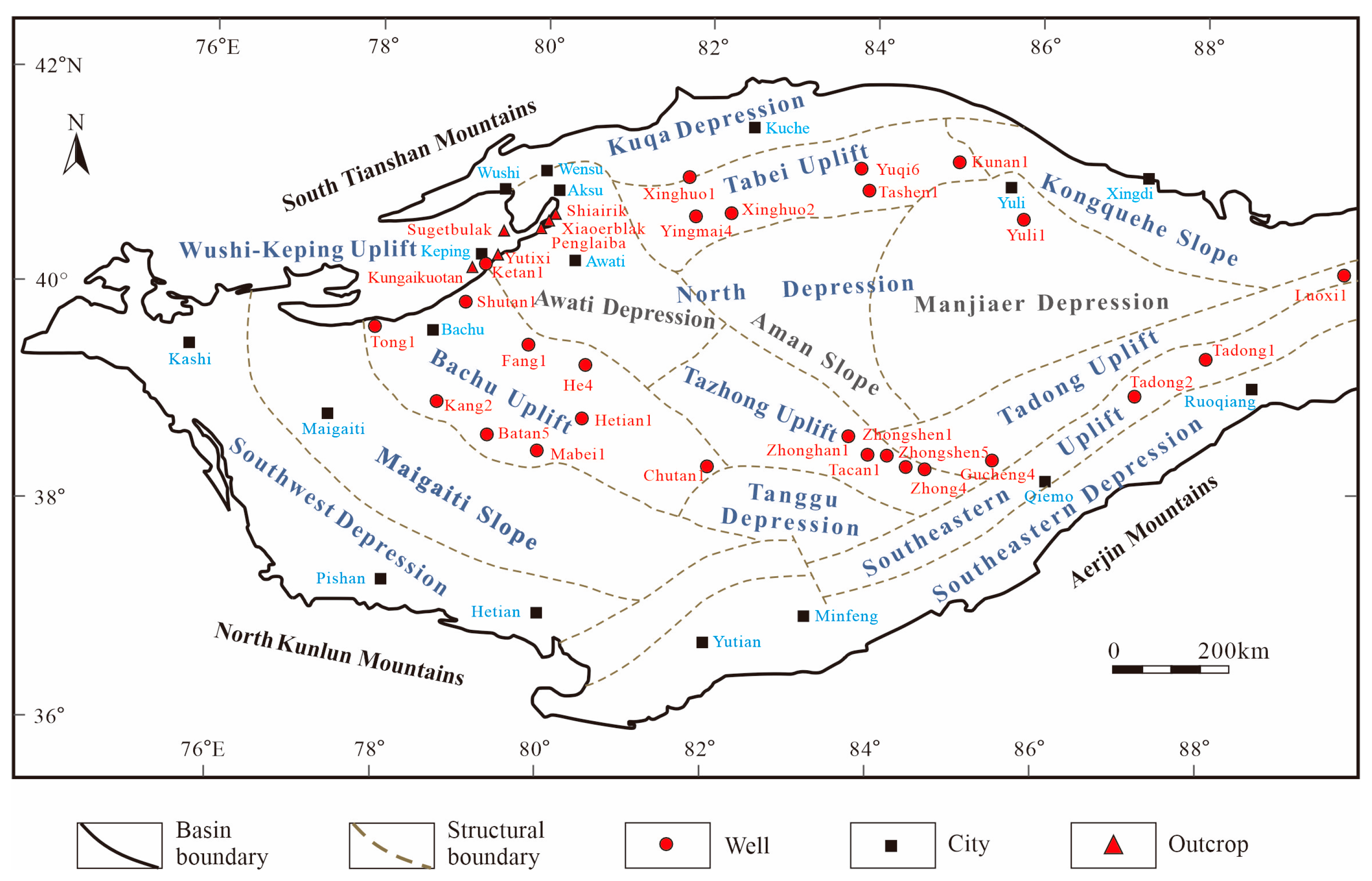
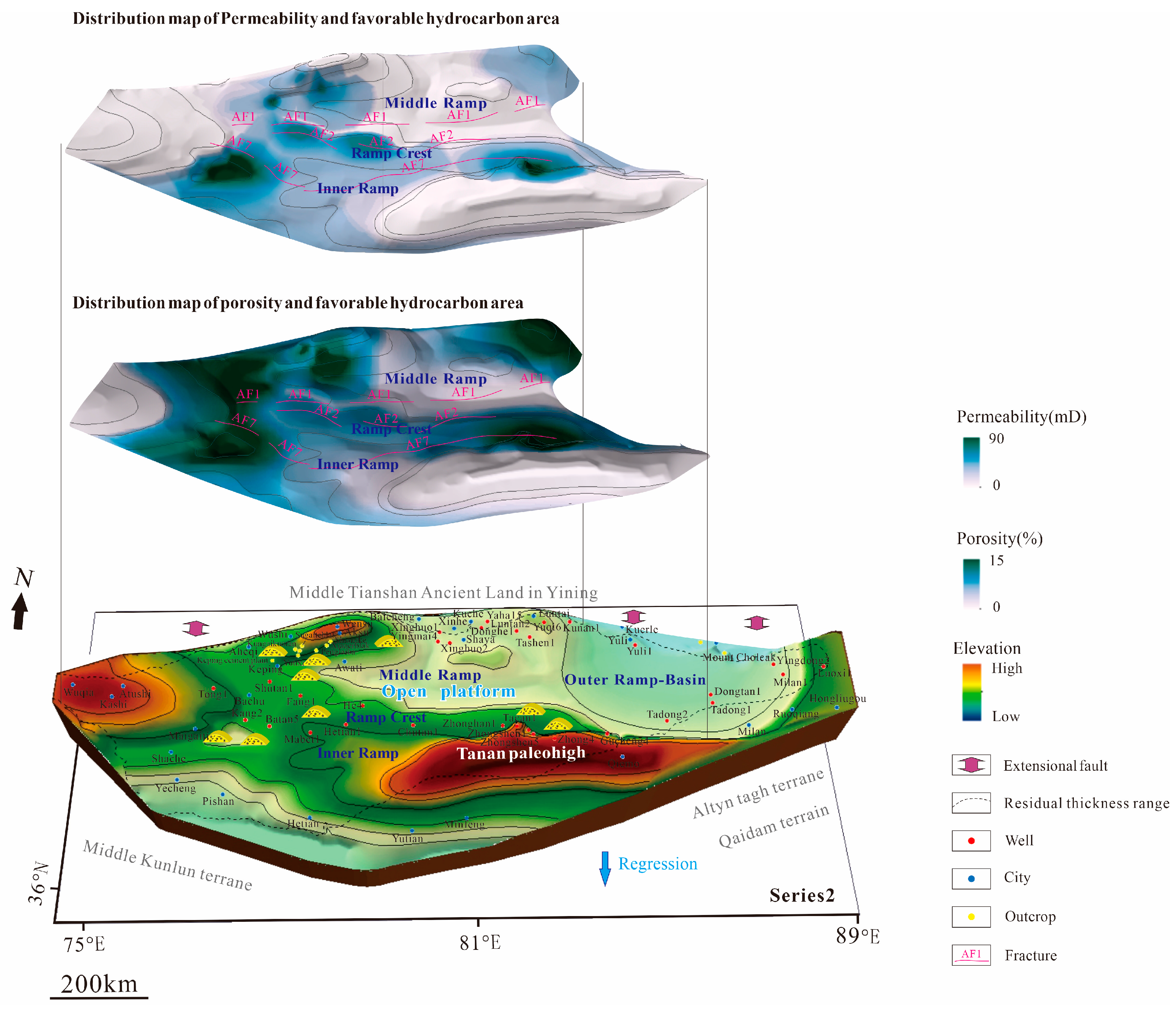

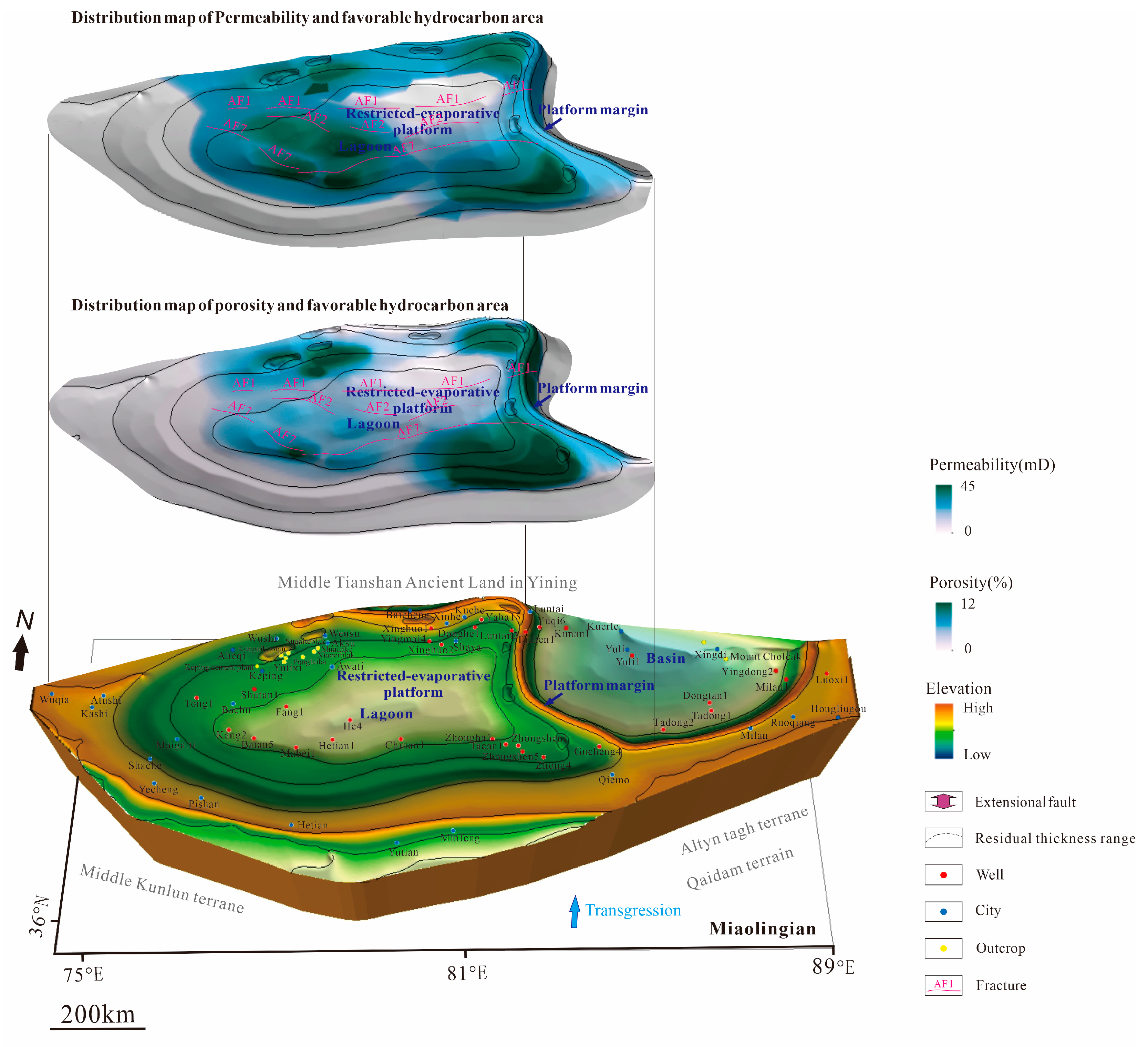
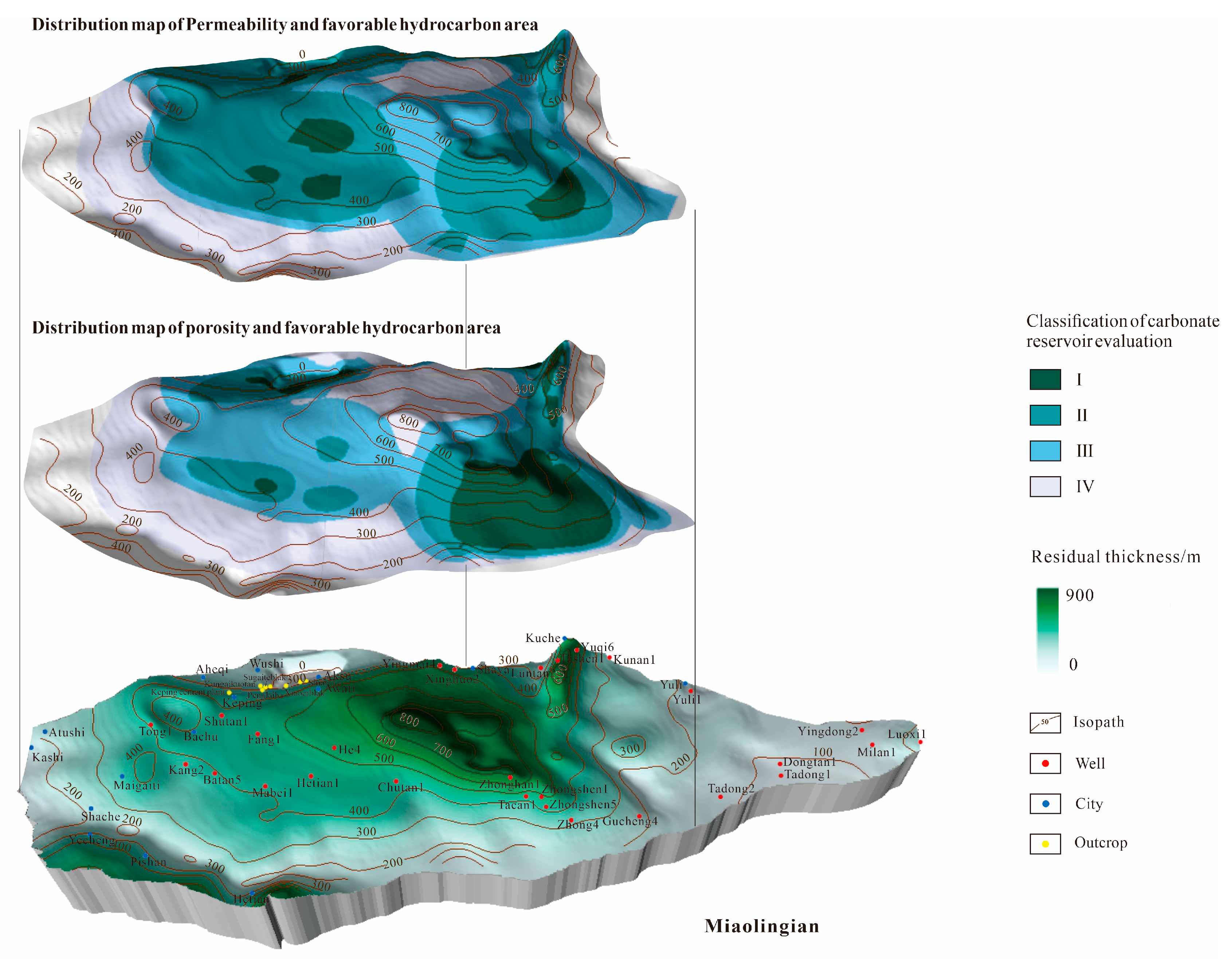
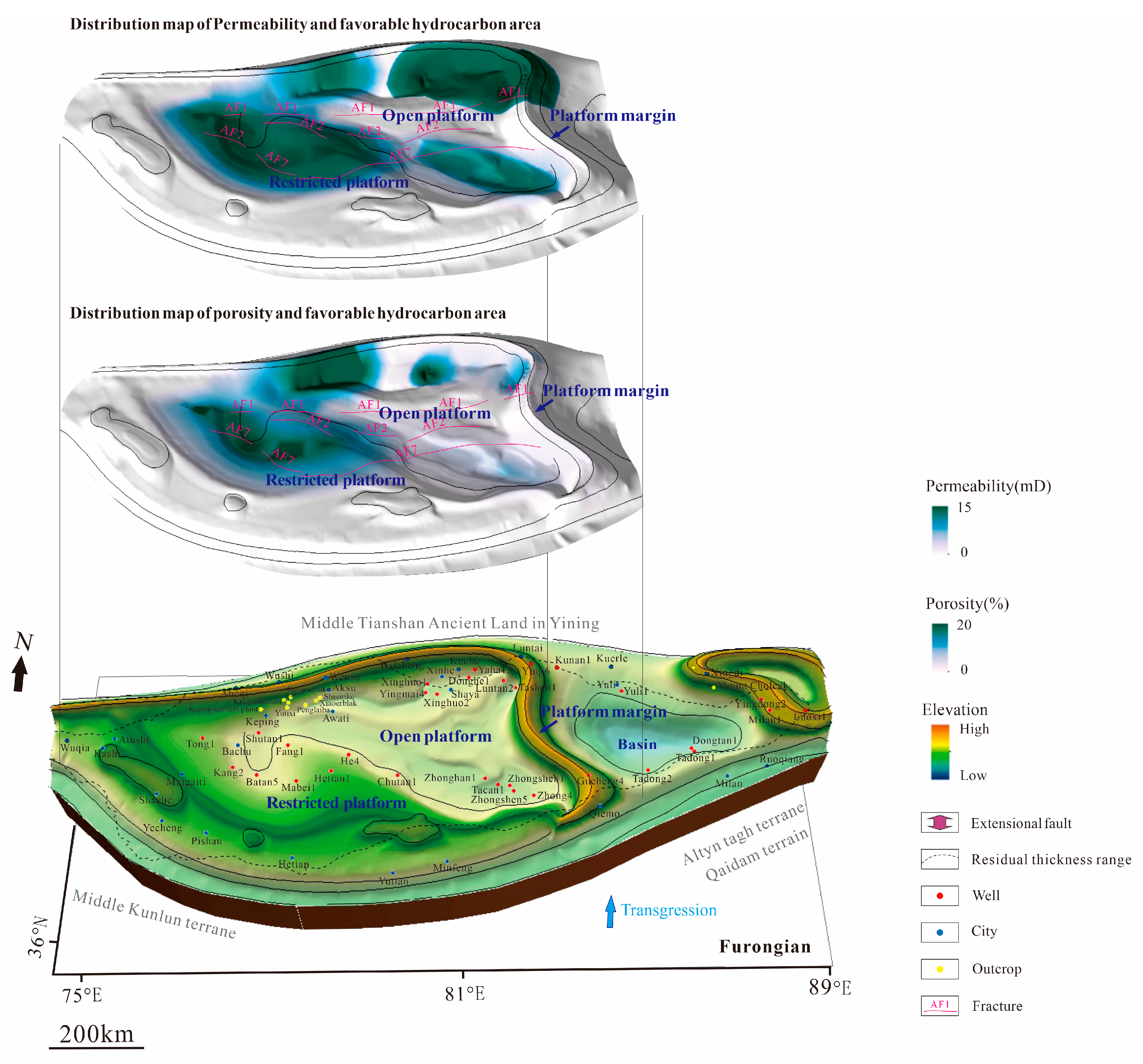

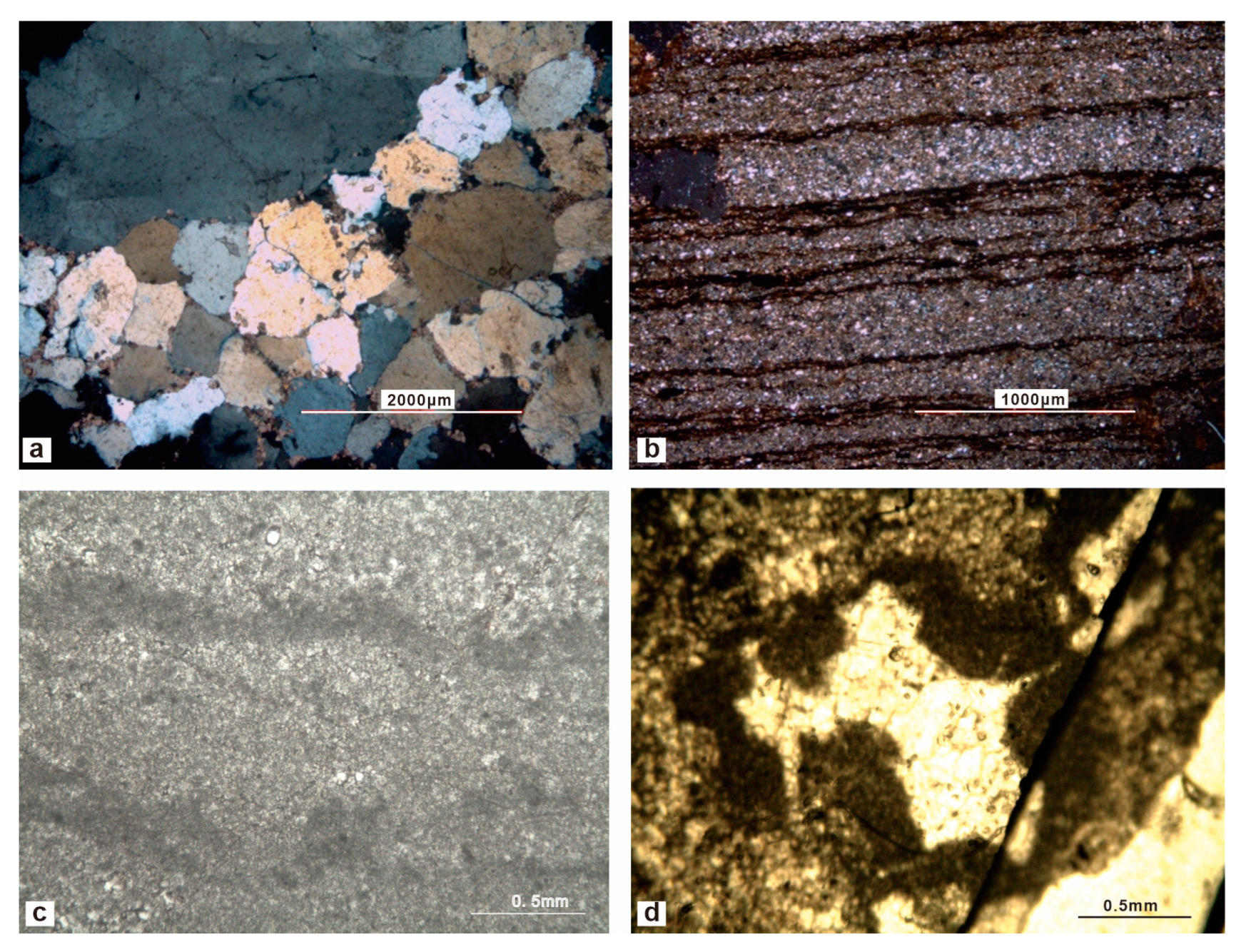
Disclaimer/Publisher’s Note: The statements, opinions and data contained in all publications are solely those of the individual author(s) and contributor(s) and not of MDPI and/or the editor(s). MDPI and/or the editor(s) disclaim responsibility for any injury to people or property resulting from any ideas, methods, instructions or products referred to in the content. |
© 2024 by the authors. Licensee MDPI, Basel, Switzerland. This article is an open access article distributed under the terms and conditions of the Creative Commons Attribution (CC BY) license (https://creativecommons.org/licenses/by/4.0/).
Share and Cite
Zhang, K.; You, X.; Ma, T.; Wang, J.; Wu, Y.; Lu, Y.; Zhang, S. The Main Controlling Factors of the Cambrian Ultra-Deep Dolomite Reservoir in the Tarim Basin. Minerals 2024, 14, 775. https://doi.org/10.3390/min14080775
Zhang K, You X, Ma T, Wang J, Wu Y, Lu Y, Zhang S. The Main Controlling Factors of the Cambrian Ultra-Deep Dolomite Reservoir in the Tarim Basin. Minerals. 2024; 14(8):775. https://doi.org/10.3390/min14080775
Chicago/Turabian StyleZhang, Kehui, Xuelian You, Tianyi Ma, Jia Wang, Yifen Wu, Yi Lu, and Shaoqi Zhang. 2024. "The Main Controlling Factors of the Cambrian Ultra-Deep Dolomite Reservoir in the Tarim Basin" Minerals 14, no. 8: 775. https://doi.org/10.3390/min14080775




